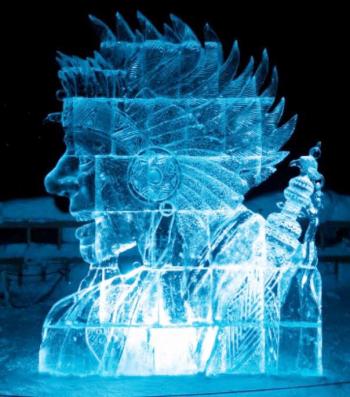Image Caption
By Andrea Smith
Windspeaker.com Contributor
While there are many beautiful ice sculptures gracing the Ice Magic Festival in Lake Louise, Alta. this week, one sculpture in particular has caught people off guard.
Despite the clear efforts that were put into making it an admirable aesthetic piece, the Eskimo Chieftain sculpture may not be entirely appropriate, according to some who have now viewed it.
The sculpture was crafted by a team from China, Riu and Ximo Xu, and is on display along with the other carvings at the Fairmont Chateau Lake Louise until Sunday.
Rita Gore from Calgary shared her confusion with Windspeaker.com at seeing the sculpture. She was snowshoeing when she saw Eskimo Chieftain and immediately thought it could be regarded as offensive to some people.
She even tweeted at Lake Louise to say: “Snowshoeing yesterday, looked at ice sculpture and saw this! (Insert photo of Eskimo Chieftain) Realize it’s carved by Chinese Team-but title “Eskimo Chieftain” with headdress?? Inaccurate, outdated, think it needs correcting.”
Gore said she believes more education is needed in this area. The details in the sculpture, she admits, are incredible on the approximately five-foot-tall sculpture, most notably the feathers. However, it’s an issue because the group the sculpture represents (Inuit, though referred improperly by the term Eskimo) do not wear feather headdresses as part of their regalia.
“It's an odd experience--well to me--to be standing there looking at a sign/ ice carving and immediately have a ‘what the heck is this?’ reaction, and no one around me acts like there is a problem,” she said.
Norma Dunning, a well-known Inuit writer and researcher, was contacted by Windspeaker.com about the sculpture . She’s been advocating against the use of the term “Eskimo” and recently asked Edmonton’s CFL team to change its name from the Edmonton Eskimos to something more culturally sensitive.
Dunning, however, is gracious in her comments about the “Eskimo Chieftain” sculpture and her mind is open to the sculptors’ intentions.
“The work is beautiful to look at, and appears to contain a great deal of detail and skill,” she said, continuing on to share her basic points of observation on the piece.
“In terms of artistic freedom, the sculptors can title their work in any way that they want. Perhaps, the title is what will draw attention from the public to look at the work, and appreciate the skill and detail that they have presented.”
Dunning adds that while she has publicly spoken about the use of the word Eskimo, she acknowledges that “Europeans and Alaskan people” still frequently use it to refer to Inuit people. Dunning also acknowledges the detail and hard work that was specifically put into certain parts of the sculpture, such as what appears to be a brass clasp on the feather bonnet, as well as the eagle head on the what Dunning thinks might be a sword or weapon.
In Dunning’s mind, the use of brass could be representative of contact with Europeans, and the fact that Inuit people used these items to create beauty.
Dunning’s final note about the piece is that “Chief” and “Chieftain” are not words to describe Inuit leadership.
“We did have leaders who were respected members of our groupings and that made consensual decisions on behalf of our families and kin, but the use of the word “Chieftain” does not represent leadership, and may be usage that is unfamiliar in Canada, in comparison to Chinese language,” she said.
Dunning also adds she does not see the sculptors as meaning any harm or racism, but simply as crafting their art in terms of their own understanding of what seems to be a blend of both Inuit, First Nations and Métis.
Director of consumer marketing for Banff and Lake Louise Tourism, Woodrow Oldford, was reached this afternoon by Windspeaker.com. Oldford shared the process of selecting ice sculpture entries, stating that photographs from their own database are made available to sculptors to choose from.
Each sculptor or group of sculptors chooses a photograph, then sketches it, and Banff and Lake Louise Tourism staff approve the proposed sculpture based on the likeness of the sketch to the photograph.
The key issue that arose with “Eskimo Chieftain”, according to Oldford, is that they were focusing on the image rather than the name of the piece, which is submitted along with the sketch.
“We cherish the beliefs and values of all cultures. This is an inclusive community. Banff National Park is Treaty 7 land and we recognize and respect our heritage and Indigenous culture. This is an embarrassing oversight. We apologize and would never set out to offend anyone,” explained Oldford in an email.
He goes on to say “This has highlighted that we need to review our application and approval process. We have removed the signage and will rename the sculpture with the assistance of the subject in the original photograph.”

